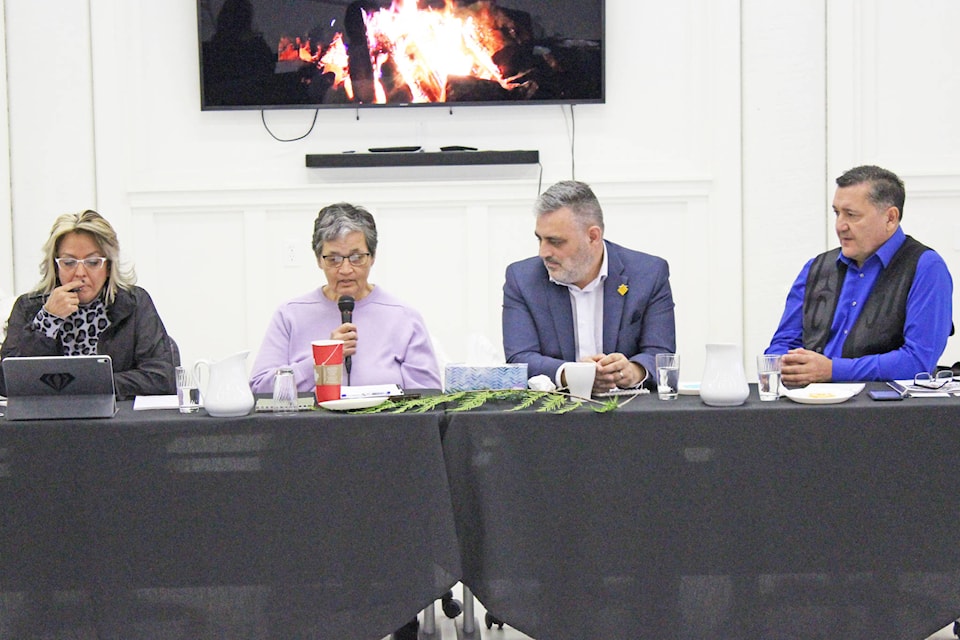Discussions on addressing affordable housing for Indigenous people are gaining momentum in the Bulkley Valley.
On Oct. 3, the Dze L K’ant Friendship Centre brought together a panel of experts on Indigenous housing to advance a project the centre has been working on for several months in collaboration with BC Healthy Communities, a not-for-profit that seeks to facilitate “the ongoing development of healthy, thriving and resilient communities.”
Lydia Howard, Dze L K’ant’s housing advisor moderated the panel.
“Last year, we received some funding to carry out a year long Indigenous housing education and awareness project,” she said in her introduction to the two-hour Oct. 3 session. “We’ve been having housing information booths at community events, and we created a survey that we distributed in the community, as well as information, and we’ve been running some workshops so people can talk about housing needs in the community.”
The panelists were Lucy Gagnon, executive director of the Witset First Nation; Rod Hill, BC Housing director of Indigenous Asset Management; Cliff Grant, manager of Indigenous strategic relations for the Aboriginal Housing Management Association; and Dze L K’ant executive director Annette Morgan.
Gagnon underscored the seriousness of the issue noting her band has a waiting list for housing of more than 100 families.
Witset is currently building a three-story, 26-unit apartment building with a $5.2 million grant from the Building BC: Indigenous Housing Fund announced last November. Gagnon said it is exciting they will be able to wipe out 25 per cent of their wait list, but it still falls well short of the need.
“One of the biggest problems we hear from our community members that live in within Smithers is there’s no place to rent, so a lot of them have to move to Houston,” Gagnon said. “It’s getting better for services there, but there’s not as many services as Smithers, so it’s a real big issue still.”
Hill, a member of a small Newfoundland First Nation, told attendees of the discussion that his path to getting involved in housing started with a geological field trip to the tiny Inuit community of Nain on the north coast of Labrador in the early 1990s.
He described the conditions he saw there as similar to a third-world nation and made him decide to abandon the geology career path and dedicate his life to helping Indigenous people find their rightful place in society.
“For Indigenous peoples to find their rightful place in Canadian society, it starts with a house, it starts with a safe place to stay, it starts with getting off the couch, that might not even be a family member’s,” he said. “[Housing] stops the cycle of finding accommodation in the winter time in the prisons, because that’s a reality in Canada, and starts making a difference so people can have a hope and future, because without a safe place to stay, you can’t really start focussing on those other significant issues.”
Hill said B.C. is getting serious about the housing problem.
“Through the department that I’m in now, we were able to develop a business case to secure a billion dollars in provincial funding to support housing across the province through a robust process of asset management,” he said.
“What [the government] said to me is, basically, ‘we’re not going to be happy with the way things are in the Indigenous world, so we’re going to extend our institutional knowledge and corporate knowledge to Indigenous communities as they choose to or wish to participate.”
In Smithers, as everywhere, Indigenous people are disproportionately represented in the homeless population. In Smithers, 72 per cent of homeless people identified as Indigenous in a 2018 survey.
Barriers to accessing housing included rent being too high (56 per cent), income being too low (48 per cent) and lack of availability (32 per cent).
Almost half of Indigenous renters reported spending more than 30 per cent of their income on rent and 22 per cent are paying 50 per cent or more of their income on rent and utilities.
